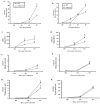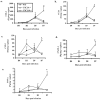CXCL9 and CXCL10 expression are critical for control of genital herpes simplex virus type 2 infection through mobilization of HSV-specific CTL and NK cells to the nervous system
- PMID: 18178850
- PMCID: PMC2185792
- DOI: 10.4049/jimmunol.180.2.1098
CXCL9 and CXCL10 expression are critical for control of genital herpes simplex virus type 2 infection through mobilization of HSV-specific CTL and NK cells to the nervous system
Abstract
CXCL9 and CXCL10 mediate the recruitment of T lymphocytes and NK cells known to be important in viral surveillance. The relevance of CXCL10 in comparison to CXCL9 in response to genital HSV-2 infection was determined using mice deficient in CXCL9 (CXCL9-/-) and deficient in CXCL10 (CXCL10-/-) along with wild-type (WT) C57BL/6 mice. An increased sensitivity to infection was found in CXCL10-/- mice in comparison to CXCL9-/- or WT mice as determined by detection of HSV-2 in the CNS at day 3 postinfection. However, by day 7 postinfection both CXCL9-/- and CXCL10-/- mice possessed significantly higher viral titers in the CNS in comparison to WT mice consistent with mortality (18-35%) of these mice within the first 7 days after infection. Even though CXCL9-/- and CXCL10-/- mice expressed elevated levels of CCL2, CCL3, CCL5, and CXCL1 in the spinal cord in comparison to WT mice, there was a reduction in NK cell and virus-specific CD8+ T cell mobilization to this tissue, suggesting CXCL9 and CXCL10 are critical for recruitment of these effector cells to the spinal cord following genital HSV-2 infection. Moreover, leukocytes from the spinal cord but not from draining lymph nodes or spleens of infected CXCL9-/- or CXCL10-/- mice displayed reduced CTL activity in comparison to effector cells from WT mice. Thus, the absence of CXCL9 or CXCL10 expression significantly alters the ability of the host to control genital HSV-2 infection through the mobilization of effector cells to sites of infection.
Figures






Similar articles
-
Herpes simplex virus type 2-induced mortality following genital infection is blocked by anti-tumor necrosis factor alpha antibody in CXCL10-deficient mice.J Virol. 2008 Oct;82(20):10295-301. doi: 10.1128/JVI.00931-08. Epub 2008 Aug 6. J Virol. 2008. PMID: 18684827 Free PMC article.
-
Susceptibility of CCR5-deficient mice to genital herpes simplex virus type 2 is linked to NK cell mobilization.J Virol. 2007 Apr;81(8):3704-13. doi: 10.1128/JVI.02626-06. Epub 2007 Jan 31. J Virol. 2007. PMID: 17267483 Free PMC article.
-
Herpes Simplex Virus Type 2 Infection-Induced Expression of CXCR3 Ligands Promotes CD4+ T Cell Migration and Is Regulated by the Viral Immediate-Early Protein ICP4.Front Immunol. 2018 Dec 19;9:2932. doi: 10.3389/fimmu.2018.02932. eCollection 2018. Front Immunol. 2018. PMID: 30619292 Free PMC article.
-
CD4+ T cell migration into the cornea is reduced in CXCL9 deficient but not CXCL10 deficient mice following herpes simplex virus type 1 infection.Cell Immunol. 2006 Oct;243(2):83-9. doi: 10.1016/j.cellimm.2007.01.001. Epub 2007 Feb 12. Cell Immunol. 2006. PMID: 17296171 Free PMC article.
-
CXCR3 Ligands in Cancer and Autoimmunity, Chemoattraction of Effector T Cells, and Beyond.Front Immunol. 2020 May 29;11:976. doi: 10.3389/fimmu.2020.00976. eCollection 2020. Front Immunol. 2020. PMID: 32547545 Free PMC article. Review.
Cited by
-
Stress keratin 17 and estrogen support viral persistence and modulate the immune environment during cervicovaginal murine papillomavirus infection.Proc Natl Acad Sci U S A. 2023 Mar 21;120(12):e2214225120. doi: 10.1073/pnas.2214225120. Epub 2023 Mar 14. Proc Natl Acad Sci U S A. 2023. PMID: 36917668 Free PMC article.
-
Blocking CXCL9 Decreases HIV-1 Replication and Enhances the Activity of Prophylactic Antiretrovirals in Human Cervical Tissues.J Acquir Immune Defic Syndr. 2016 Apr 15;71(5):474-82. doi: 10.1097/QAI.0000000000000891. J Acquir Immune Defic Syndr. 2016. PMID: 26545124 Free PMC article.
-
Activation of Interferon-Stimulated Genes following Varicella-Zoster Virus Infection in a Human iPSC-Derived Neuronal In Vitro Model Depends on Exogenous Interferon-α.Viruses. 2022 Nov 14;14(11):2517. doi: 10.3390/v14112517. Viruses. 2022. PMID: 36423126 Free PMC article.
-
Differential gene expression patterns of EBV infected EBNA-3A positive and negative human B lymphocytes.PLoS Pathog. 2009 Jul;5(7):e1000506. doi: 10.1371/journal.ppat.1000506. Epub 2009 Jul 3. PLoS Pathog. 2009. PMID: 19578441 Free PMC article.
-
Herpes simplex virus type 2-induced mortality following genital infection is blocked by anti-tumor necrosis factor alpha antibody in CXCL10-deficient mice.J Virol. 2008 Oct;82(20):10295-301. doi: 10.1128/JVI.00931-08. Epub 2008 Aug 6. J Virol. 2008. PMID: 18684827 Free PMC article.
References
-
- Inagaki K, Daikoku T, Goshima F, Nashiyama Y. Impaired induction of protective immunity by highly virulent herpes simplex type 2 in a murine model of genital herpes. Arch Virol. 2000;145:1989–2002. - PubMed
-
- Harandi AM, Svennerholm B, Holmgren J, Eriksson K. Differential roles of B cells and IFN- -secreting CD4+ T cells in innate and adaptive immune control of genital herpes simplex virus type 2 infection in mice. J Gen Virol. 2001;82:845–853. - PubMed
-
- Whitley RJ, Miller RL. Immunologic approach to Herpes Simplex Virus. Viral Immunol. 2001;14(2):111–118. - PubMed
-
- Duerst RJ, Morrison LA. Innate immunity to herpes simplex virus type 2. Viral Immunol. 2003;16(4):475–490. - PubMed
-
- MasCasullo V, Fam E, Keller MJ, Herold BC. Role of mucosal immunity preventing genital herpes infection. Viral Immunol. 2005;18(4):595–606. - PubMed
Publication types
MeSH terms
Substances
Grants and funding
LinkOut - more resources
Full Text Sources
Other Literature Sources
Medical
Molecular Biology Databases
Research Materials

